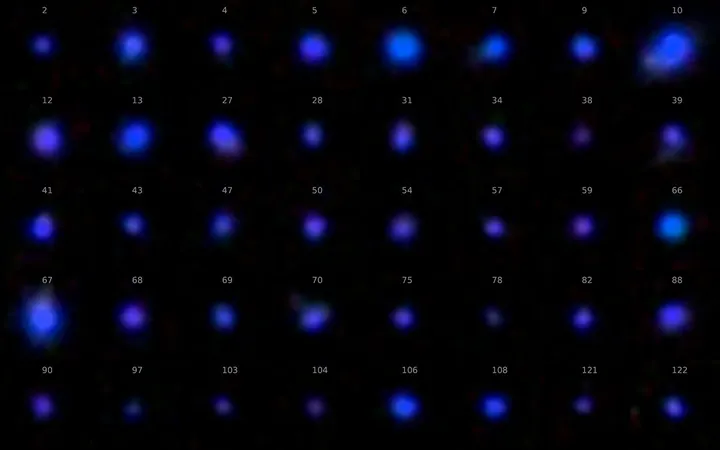
Discovering Blueberry Galaxies: A Key to Unlocking the Secrets of Distant Green Peas!
2024-11-05
Author: John Tan
The Green Pea Mystery Explained
Green Pea galaxies, compact symmetrical systems that are green in hue, were first identified by enthusiastic volunteers participating in the Galaxy Zoo project. These dwarf galaxies stand out because of their unusual brightness, tracing their vibrant green color to intense star formation activity and the emission of oxygen. Strikingly, they are efficient star factories, producing new stars at rates that would be astonishing even for galaxies ten times their size.
While previous studies identified their unusual luminosity, newer research utilizing the powerful James Webb Space Telescope revealed another layer of intrigue. High-redshift observations show these galaxies bear a striking resemblance to other ancient cosmic bodies, suggesting they might be the universe’s last survivors from a spectacular era of star formation that many galaxies have long since outgrown.
Introducing the Blueberry Galaxies
Despite being more familiar to us, studying Blueberry galaxies offers a window into understanding Green Peas—a task that astronomers have taken on with excitement. Located between 2.5 and 4 billion light years away, the Blueberries are more local than their distant Green Pea cousins.
These round blue galaxies, recently subjected to examination through the European Space Agency’s XMM-Newton telescope, have yielded unexpected results. In their inaugural X-ray observations, researchers were puzzled to find that most of these galaxies emitted significantly less X-ray radiation than anticipated for their size, with all but two falling below detection thresholds.
What’s Behind the Blueberry Quandary?
So why the discrepancy? One theory posits that these galaxies may be in their infancy, forming stars rapidly over a brief five-million-year span. This relatively short timeframe suggests they haven’t had enough opportunity to evolve binary star systems—pairings of regular stars with neutron stars or black holes that typically result in robust X-ray emissions.
However, one Blueberry galaxy, delightfully named BB8 (a nod that will surely resonate with Star Wars fans), stood out for its unexpectedly bright glow. Researchers speculate that this anomaly might indicate the presence of a developing black hole, lending to ongoing debates about why only BB8 shows such an extraordinary luminosity.
With more questions than answers emerging from these groundbreaking observations, it’s clear astronomers will devote future research efforts toward unraveling the mysteries of Blueberry galaxies for years to come.
Conclusion
In summary, while Blueberry galaxies may seem less exotic at first glance compared to their vibrant Green Pea counterparts, they harbor secrets crucial for understanding star formation across the universe. Stay informed, as this fascinating field of research continues to evolve, paving the way for future discoveries that might transform our understanding of the cosmos!



 Brasil (PT)
Brasil (PT)
 Canada (EN)
Canada (EN)
 Chile (ES)
Chile (ES)
 Česko (CS)
Česko (CS)
 대한민국 (KO)
대한민국 (KO)
 España (ES)
España (ES)
 France (FR)
France (FR)
 Hong Kong (EN)
Hong Kong (EN)
 Italia (IT)
Italia (IT)
 日本 (JA)
日本 (JA)
 Magyarország (HU)
Magyarország (HU)
 Norge (NO)
Norge (NO)
 Polska (PL)
Polska (PL)
 Schweiz (DE)
Schweiz (DE)
 Singapore (EN)
Singapore (EN)
 Sverige (SV)
Sverige (SV)
 Suomi (FI)
Suomi (FI)
 Türkiye (TR)
Türkiye (TR)
 الإمارات العربية المتحدة (AR)
الإمارات العربية المتحدة (AR)